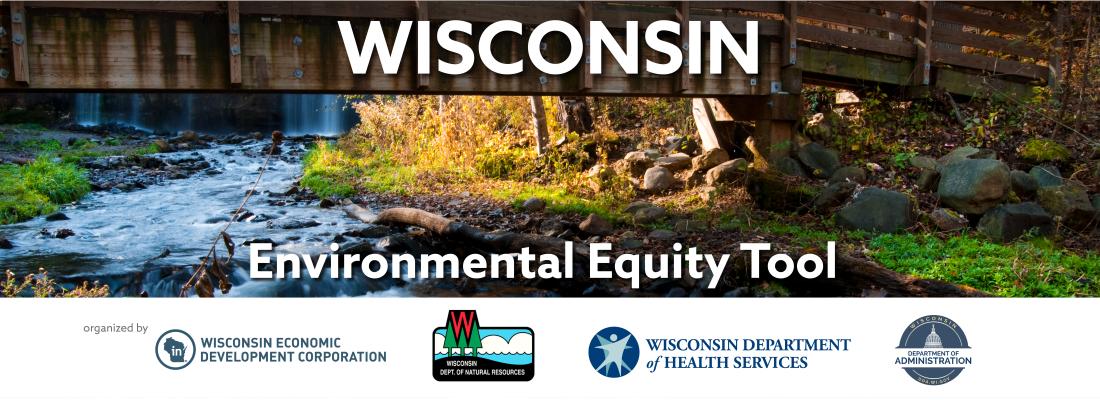The Wisconsin Environmental Equity Tool
What is the Wisconsin Environmental Equity Tool?
The Wisconsin Environmental Equity Tool (WEET) is a comprehensive web-based environmental justice and health equity mapping tool that is being developed by the Wisconsin Economic Development Corporation (WEDC) and three other state agencies in consultation with partner organizations, community members and local government.
The online tool will combine, analyze and visualize data, so government and tribal agencies, community-based organizations, and the public can pinpoint Wisconsin’s most impacted communities. The tool will help all users better understand the challenges impacted communities face from pollution, a changing climate, socioeconomic factors, and other environmental and health hazards.
We want to hear from you
We want to ensure the mapping tool reflects real-world experiences, especially Wisconsin’s communities of color, low-wealth communities, rural communities, Tribal Nations, and immigrant communities. These communities are often burdened with the greatest environmental and health impacts from pollution and climate change.
We also want to learn about your successes, challenges, and needs, as well as what you hope to see in the new tool.
Please send any written comments or ideas to EnvEquity@wedc.org and sign up to receive project update emails to stay informed.
The purpose of the Wisconsin Environmental Equity Tool is to provide a state-specific environmental equity screening and mapping tool using more detailed local and state data. Local data can better characterize on-the-ground conditions in communities to help policy-makers, service providers, community members, and stakeholders:
- Better understand areas of environmental, public health, and climate vulnerability;
- Focus local and state programs and policies to advance environmental equity; and
- Inform funding priorities and awareness activities.
A wide range of stakeholders – from community members, government officials, elected officials, public health professionals, to nonprofits – can use the Wisconsin Environmental Equity Tool to build community awareness and educational campaigns, inform policy and program planning, prioritize funding for investment and interventions, conduct community health assessments, write data-driven grant proposals, strengthen community organizing efforts, and more.
The Wisconsin Environmental Equity Tool will help Wisconsin meet its commitment to reduce health inequities and advance environmental equity. The primary state agencies leading the development of Wisconsin Environmental Equity Tool, include:
- Wisconsin Economic Development Corporation (WEDC)
- Department of Administration (DOA)
- Department of Health Services (DHS)
- Department of Natural Resources (DNR)
The WEET Ad Hoc Advisory Committee provides ongoing input and recommendations on the tool from a wide range of community members and professionals. Learn more about the advisory committee on WEDC's website.
Many other states and the federal government have development similar mapping tools to identify and learn about communities’ public health, environmental and climate change burdens. Washington State, California, and Maryland use the most comprehensive approaches to environmental justice screening that characterize cumulative impacts that disproportionately impact communities of color, low-income communities, rural communities, Tribal Nations, and other indigenous communities.
These environmental justice screening tools create a transparent scoring or index feature to examine both cumulative impacts and social vulnerability. The index can help communities and organizations to make informed decisions to improve the health, resilience, and sustainability of overburdened communities.
Below are links to select environmental justice screening and mapping tools:
- Environmental Protection Agency, EJScreen
- California, CalEnviroScreen
- Maryland, MD EJScreen
- Washington, Washington Environmental Health Disparities Map
Public input throughout the project has helped shape the tool design, and identify data gaps, ongoing upgrades and maintenance, and other needs. Similar tools developed in other states included economic, social, environmental, climate change, health, and other relevant data that is easily accessed.
A list of Wisconsin data currently available through state and federal databases are listed below, and they may be included in WEET if they meet data quality and compatibility standards. Much of this data is already available in a map format on the Department of Natural Resources website.
Population category
- Heart disease (cardiovascular)
- Low birth-weight infants
- Asthma emergency room visits
- Poverty
- Race and ethnicity
- English language skills
- Education level
- Unemployment
- Housing burden
- Transportation expense
- Health insurance
- Tribal land
Environment category
- Sites storing a hazardous substance that require a plan to address potential risks to public health and the environment (Risk Management Plan Sites)
- Distance from federally managed contaminated sites (National Priority List or Superfund)
- Distance from facilities that store, treat, transport or dispose of hazardous waste
- Impaired lakes, rivers and streams
- Location of solid waste sites and facilities, such as landfills
- Concentration of ground-level ozone pollution in the air
- Concentration of tiny particle pollution in the air (particulate matter or PM2.5)
- Air emissions from diesel fuel
- Traffic density and distance from high-traffic areas
- National assessment that estimates cancer and non-cancer risks from breathing toxic air pollution (NATA)
- Wastewater discharges
- Childhood lead poisoning
- Public drinking water index
- Chemical pesticide use
- Respiratory hazard index
Climate change category
- Social Vulnerability Index - housing type and transportation index
- Average percent of developed land where water cannot soak into the ground
- Distance to flood zones
- Tree canopy
Questions?
Please contact WEDC at 608-210-6700, or email EnvEquity@wedc.org, or visit the WEDC website.



